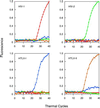Multiplex detection of four pathogenic retroviruses using molecular beacons
- PMID: 10339598
- PMCID: PMC26892
- DOI: 10.1073/pnas.96.11.6394
Multiplex detection of four pathogenic retroviruses using molecular beacons
Abstract
We describe a multiplex nucleic acid assay that identifies and determines the abundance of four different pathogenic retroviruses (HIV-1, HIV-2, and human T-lymphotrophic virus types I and II). Retroviral DNA sequences are amplified in a single, sealed tube by simultaneous PCR assays, and the resulting amplicons are detected in real time by the hybridization of four differently colored, amplicon-specific molecular beacons. The color of the fluorescence generated in the course of amplification identifies which retroviruses are present, and the number of thermal cycles required for the intensity of each color to rise significantly above background provides an accurate measure of the number of copies of each retroviral sequence that were present originally in the sample. Fewer than 10 retroviral genomes can be detected. Moreover, 10 copies of a rare retrovirus can be detected in the presence of 100, 000 copies of an abundant retrovirus. Ninety-six samples can be analyzed in 3 hr on a single plate, and the use of a closed-tube format eliminates crossover contamination. Utilizing previously well characterized clinical samples, we demonstrate that each of the pathogenic retroviruses can be identified correctly and no false positives occur. This assay enables the rapid and reliable screening of donated blood and transplantable tissues.
Figures




References
-
- Popovic M, Sarngadharan M G, Read E, Gallo R C. Science. 1984;224:497–500. - PubMed
-
- Clavel F, Guetard D, Brun-Vezinet F, Chamaret S, Rey M A, Santos-Ferreira M O, Laurent A G, Dauguet C, Katlama C, Rouzioux C, et al. Science. 1986;233:343–346. - PubMed
-
- Kalyanaraman V S, Sarngadharan M G, Robert-Guroff M, Miyoshi I, Golde D, Gallo R C. Science. 1982;218:571–573. - PubMed
-
- Bhagavati S, Ehrlich G, Kula R W, Kwok S, Sninsky J, Udani V, Poiesz B J. N Engl J Med. 1988;318:1141–1147. - PubMed
Publication types
MeSH terms
Substances
Grants and funding
LinkOut - more resources
Full Text Sources
Other Literature Sources

